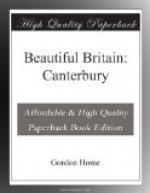A century ago, when appreciation of the architecture of the dead centuries when Englishmen built with superlative skill had ebbed to its lowest, the Abbey had sunk to inconceivably debased uses. The monastic kitchen had been converted into a public-house, and the great gateway—the finest structural relic of the Abbey—had become the entrance to a brewery, while cock-fighting took place in the state bedroom above. The pilgrims’ guest hall, now the college dining-hall, had become a dancing-hall, and the ground, unoccupied by buildings, soil hallowed by the memories of so many saintly lives and associated with the momentous days when England was being released from the toils of pagan ignorance became known as “the Old Palace Tea-gardens.” The popular mind had seemingly forgotten the original uses of the place they were desecrating with fireworks and variety shows.
At last, in 1844, Mr. Beresford Hope rescued the half-destroyed remnants of the abbey-palace, and through his generosity the present missionary college was founded, and the buildings restored or reconstructed. A more happy idea could scarcely have been suggested than that of associating the abbey founded by the first missionary of Christianity to England with modern efforts to carry the light into the dark places of the earth. The much-restored gateway, built by Abbot Fyndon at the beginning of the fourteenth century, the guest-hall, and part of the memorial chapel, are the chief portions of the old structures incorporated into the buildings that surround three sides of the college quadrangle. Standing apart to the south is one of the huge walls of the nave of the abbey church, and to the east are the extensive excavations of the east end of the crypt and other fascinatingly early remains of the historic churches mentioned in an earlier chapter (p. 17).
Leaving the Abbey grounds, and continuing to the east, one reaches in a few minutes the little church of St. Martin set on the knoll to which Queen Bertha directed her steps. It is, however, a disappointingly familiar type of Early English village church to the casual glance, and until the fabric and the remarkable font have been examined and discussed in the light of modern scientific archaeology it is difficult to appreciate the hoary antiquity of at least parts of the structure. To understand the indications of the Saxon, or possibly Roman, work in the fabric, and to know the reasons for considering the font a relic of Saxon times, it is scarcely possible to find a better instructor than Canon Routledge, whose little book is all one can desire.




